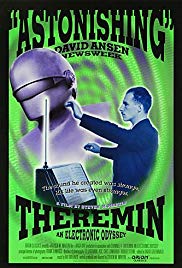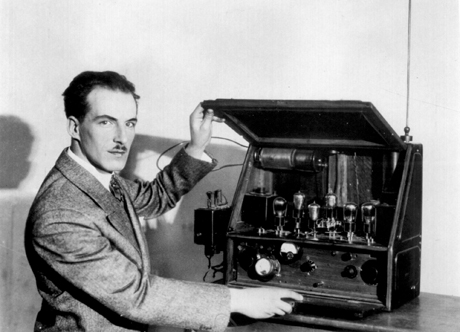AN ELECTRONIC ODYSSEY
SNIPPET LESSON PLAN: ELECTROMAGNETIC WAVES, INDUCTION, CAPACITANCE, AND ANTENNAE
Subject: Science & Technology — Physics; Music;
Ages: 12+: Middle and High School Levels
Length: Snippet: 9.5 minutes.
There is NO AI content on this website. All content on TeachWithMovies.org has been written by human beings.

SNIPPET LESSON PLAN: ELECTROMAGNETIC WAVES, INDUCTION, CAPACITANCE, AND ANTENNAE
Subject: Science & Technology — Physics; Music;
Ages: 12+: Middle and High School Levels
Length: Snippet: 9.5 minutes.
Using the Snippet in Class:
Students will be shown an unusual application of common concepts of electromagnetism, such as induction, electromagnetic waves, and capacitance. When used in music classes, students will also be shown the origin of electronic instruments, the difference between fretted and unfretted instruments, and the difficulty of playing the latter.
Concepts from electromagnetism are often introduced in a rather abstract manner. This lesson plan provides a striking and memorable way to demonstrate phenomena related to electromagnetic induction and capacitance. It may also be useful to introduce concepts of music such as the difference between fretted and unfretted instruments and the need to have a good ear to play the latter.
The first 9.5 minutes of the documentary introduces Leo Theremin and his invention, with some explanations about the principles by which this electronic instrument works.
The fascination of the Theremin lies in its apparently magical ability to transform hand movements into sounds without any physical contact. This first electronic instrument makes use of two antennae which emit and receive invisible signals and transform them into sound. However, the person playing the Theremin is not emitting signals that the antennae could receive, but seemingly plays the instrument without affecting it in any way.
In order to understand the solution to this mystery let us first address how antennae work with common audio and video signals. Antennae are made of metal, because metals are good conductors of electricity. The electrons in the antennae can easily move about and a controlled motion —an oscillating motion— is induced in the antennae by the electromagnetic waves which arrive from an emitter far away. (In the same way a cork floating in water and out of reach will be caused to move up and down by waves that transport the oscillation to it.) The emitter controls this motion by modulating the frequency (FM = frequency modulation) or amplitude (AM = amplitude modulation) of the waves, thus encoding the desired information that the antennae can then relay to the decoders in our radio or TV sets.
So, the radio and TV signals are waves made of oscillating electromagnetic fields (just as waves in water are made of oscillating water particles). We also know that the radio and TV signals are not the only electromagnetic fields present around us in the air. There are other communication signals, like those of mobile phone communication. Magnetic fields are generated by electric currents as well as magnets (that’s why there are interferences in car radios when driving past or along a power line). Electric fields are generated by electric charges and changing magnetic fields. (The symmetry between these two sentences is the basis of the theory of electromagnetism as most elegantly formulated by James C. Maxwell, but that is beyond the scope of this lesson plan.)
All objects have a certain capacity to store electrical charges, called capacitance. This is extensively used in electronic circuits in whichcapacitors are used to temporarily store electrical charge, especially when a certain minimal amount of it is needed to produce a desired effect. Capacitors have two identical elements (usually plates) separated from each other so that electric charge can be accumulated on one of them before it is suddenly released to the other, e.g. by reaching a threshold above which a spark will transport all the charge from one to the other. Capacitors are used in neon lights. In order to be switched on these lights need a high amount of charge to be released. This is why there is always a capacitor attached to every one of them. When power is given to such lights by pressing the switch, the capacitor quickly accumulates the charge and then releases the necessary amount for the neon to begin shining. In a way, it can be said that the capacitor has “condensed” the otherwise flowing charge into a “lump.” This is why capacitors were formerly known as “condensers,” a word that is still used in most languages for these elements of electric circuits.
Capacitance (C) is commonly introduced as a measure of the amount of charge (Q) stored on each plate of the capacitor for a given potential difference or voltage (V)
C= Q/V.
However, its real meaning is better understood if the formula is rearranged to
Q=CV
and explained as the proportionality factor that determines how much charge can be accumulated if induced by a given voltage: a higher capacitance will allow the storage of a higher amount of charge.
The Theremin works because the human body has a capacitance, which means that it naturally stores a certain amount of electric charge with respect to its environment or nearby objects. On dry days, walking with rubber soled shoes on synthetic material can very quickly charge our body to the point that it has to release a small but annoying charge, especially when it comes unexpectedly. Without reaching these extreme conditions, people store a small amount of charge at all times. This charge inevitably generates an electric field, and this electric field can affect the electrons in a metal rod, as for example an antenna. (This can often be experienced when one manually tries to orient the antenna for better reception and this annoyingly changes when you move away from it!)
When the electrons of an antenna are oscillating, the proximity of a human being, or even small parts of a person such as the hands, can produce alterations in the oscillation patterns in the antenna. In the case of antennae acting as receivers of radio or TV signals this can be a nuisance, but in a Theremin it can be used to generate music! The oscillation of the electrons of the two antennae in a Theremin are induced by an oscillator inside the apparatus, and these oscillations are continuously transformed into sound by a carefully adjusted electronic sound generator (just as in the case of the radio receiver). When the hand of the player approaches the antennae, the electrical field produced by the electrical charges stored in the body changes the oscillation from the oscillators. This is picked up by the antennas and, due to the circuitry in the Theremin, this change changes the pitch and the volume of the sound that is being generated.
The first of the lessons by Thereminist Thomas Grillo (7 minutes 31 seconds) shows how the interaction between the movements of the hand and the antennae control the sounds made by a Theremin. It also shows the extreme sensitivity a Theremin has with respect to small position changes of the hands. Watching these lessons is very enticing and one may feel the urge to try for oneself. In fact, the Theremin is quite difficult to play. One of the reasons is that there are no set keys or frets for specific notes, but instead, it offers a continuous range of potential sounds of varying pitch. It is like the human voice or the trombone: the singer/player has to be very sure that each note is correct and a very good musical ear is needed. There is no instrument tuner as with a piano who comes to tune a Theremin!
The Theremin has been used several times in popular music. The Theremin was used by Brian Jones of The Rolling Stones in the 1967 albums “Between the Buttons” and “Their Satanic Majesties Request.” A variation of the Theremin (without the loop) was used by Jimmy Page of Led Zeppelin during performances of “Whole Lotta Love” and “No Quarter”.
Movies in which the Theremin is used in the soundtrack include: Spellbound, The Red House, The Lost Weekend The Spiral Staircase, Rocketship X-M, The Day the Earth Stood Still, The Thing (From Another World), The Ten Commandments (the 1956 DeMille film), The Delicate Delinquent, Monster House, Ed Wood The Machinist and Hellboy.

Leon Theremin was born in Russia in 1896. He was a scientist, inventor, and musician. He invented the Theremin in 1920 after noticing that the human body would change the waves produced by an oscillator. He played the instrument for Vladimir Lenin, the first ruler of the Soviet Union and was sent on an international tour to show the world the sophistication of Soviet science.
Theremin moved to the U.S. several years later, living in New York City as a celebrity inventor. There was quite a bit of interest in his instrument and it was used in concerts with some symphony orchestras. Suddenly, in 1938 Theremin disappeared. Some said that he fled debt collectors. Others claimed that he was dead. Still others asserted that he had been kidnapped by the Soviet secret police, the KGB. Whatever happened, he returned (or was brought back) to Russia and was sent to a special Gulag in Siberia for “re-education” along with many other Russian intellectuals who had left the Soviet Union or who were considered unreliable by Stalin, the Soviet dictator. In the camp Theremin was recruited to work for the KGB. He invented a miniature listening device used by Russian spies during World War II. This was considered so important by Soviet authorities that Theremin received the Lenin Prize and was rehabilitated.
By the 1990s Theremin was back in New York where he lived out his life and was discovered by a documentary film-maker who made the movie that will be seen in this lesson.
1. Read the Helpful Background section of this Lesson Plan. Review the link to the lesson by Thereminist Thomas Grillo to determine if you want to show it to your class.
2. If you can have a real Theremin or Theremin-like device in class, it would make the lesson all the more interesting.
3. Decide how to integrate the film clip into your lesson plan.
4. Cue the DVD so that it will start at the beginning of the movie without coming attractions, advertisements or credits.
You may want to add some or all of the following projects and activities to your lesson plan.
Have students write an essay or make short presentations to the class on the following subjects:
Students looking for extra credit can build a device that makes noise based on the capacitance of the human body.
This Snippet Lesson Plan was written by Erik Stengler, Ph.D., and James Frieden. It was last revised on October 11, 2013.